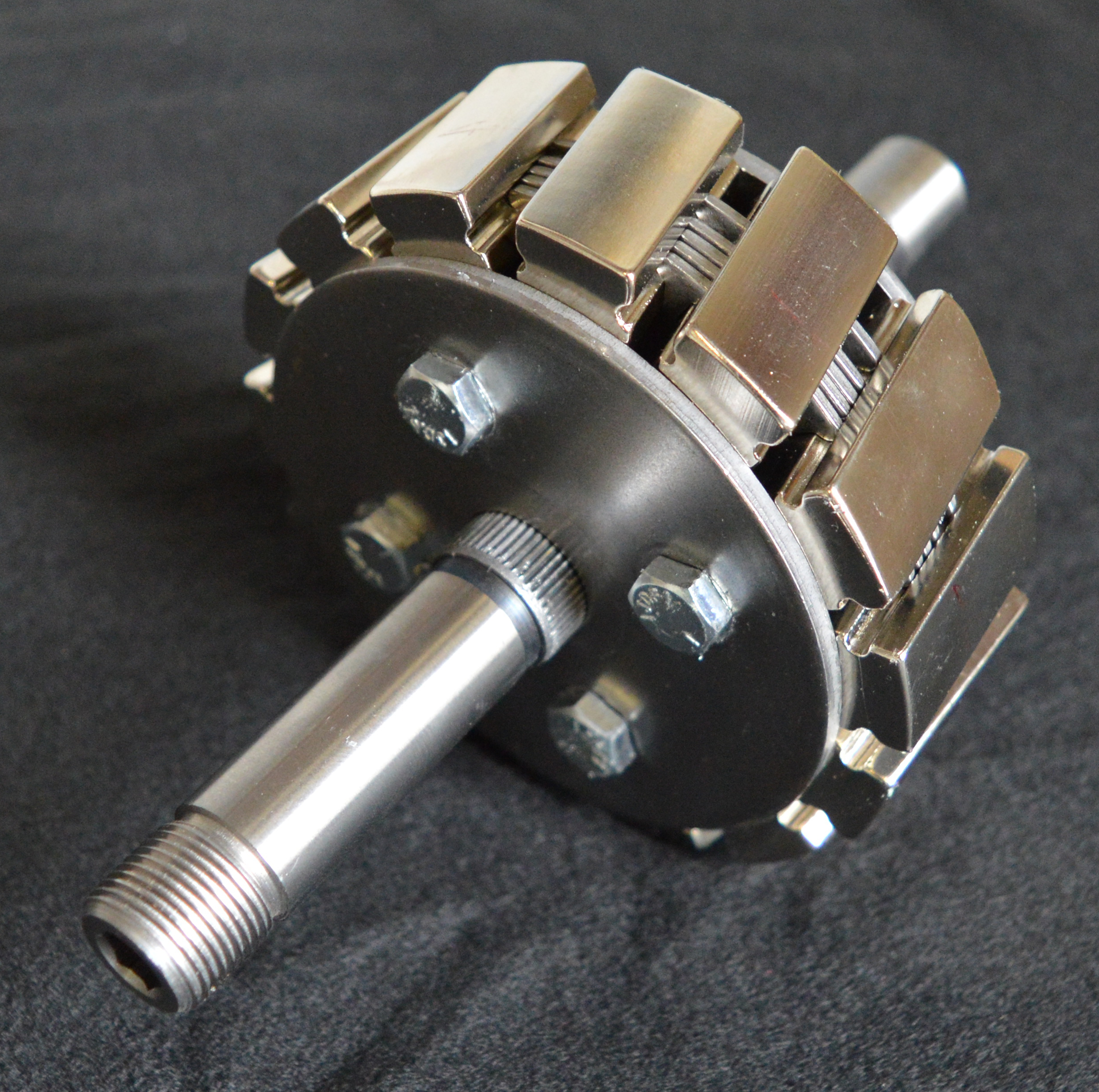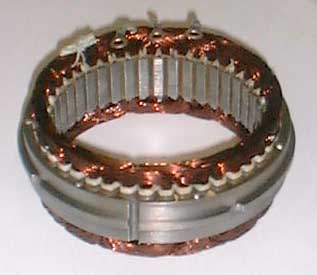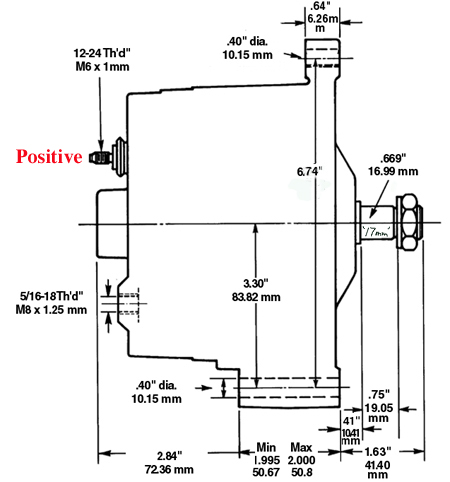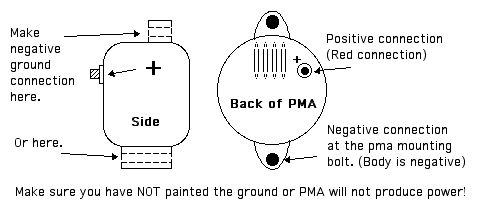- NOTE:
- These Ratings are ONLY to be used
as a basic guide line.
- Voltages are usually much higher
than shown so expect more.
-
- NOTE: Our model numbers have
nothing to do with voltages.
Ohms
law calculator
NOTE: These Ratings are
ONLY to be used as a basic guide line. Voltages may be higher
than shown.
-
- NOTICE FOR ANY OF YOU A.E. NOVICES OUT
THERE:
-
- A battery is basically a BIG capacitor in electronic terms.
Once your batteries are fully charged you must THEN
stop putting any additional power into it!
-
- Wind is unpredictable so at low wind
speeds you want to make sure that your PMA can still exceed the
voltage of your battery bank. (11 volts at a 200 amp potential
going into a 12 volt battery = zero charge)
-
- Tech notes:
Do not attempt to use a pulley smaller than 2 5/8" - The
belt tension required to keep the belt from slipping on a smaller
pulley will severely limit bearing life.
-
- 5 to 8 HP engines are the most popular
power choice for people trying to achieve maximum results from
their PMA's.
 TECH NOTES:
TECH NOTES:
-
- Taking apart a PMA the right way.
-
- 1. Remove the 4 housing bolts and pull the front housing
off OVER the shaft. Never pull the rear housing off first!!!!
If it is jammed or rusted use some WD-40 on the shaft and alternately
tap the mounting wings with a hammer while applying pressure
to the shaft with your thumb so that the stator and it's delicate
wiring harness is kept in place. NOTE: If the shaft is scored-up
badly you may have to sand the shaft down to it's original 17mm
size to get the front housing off.
-
- 2. Now grab the exposed rotor core shaft and pull it out
WHILE holding down the stator ring with your index
- finger and thumb. This will take LOTS of strength!!!!! If
you fail to hold the stator in place the core and stator
- will be extracted together and the wires will be torn off
of the stator and this is unrepairable! This is a tricky maneuver
and usually takes some experience and lots of muscle!!!!!!!
-
- 3. Once the rotor core has been successfully extracted the
rectifier connections are exposed and you may now unfasten the
three wire nuts to safely remove the stator coil. (To reassemble
simply reverse procedure)

-
- Warranties will be void on any PMA that is opened by a customer.
- Any PMA experimentation and examination is at your own risk.
-

-
CLICK DRAWING
TO ENLARGE
-
These PMA's have no over heat protection. These PMA's will
try to push ANY load you place on them until the coils literally
burn up. You have to exercise caution during R&D of new products
and check frequently for any over heating. You especially have
to exercise caution when using an engine or other high torque
driver to turn them. Use the proper circuit breaker and wire size
for your load. It is very easy and very tempting to operate them
past their over heating limits but be warned if you burn up a
PMA it is going to be your fault and not ours so watch them very
carefully during R&D for over heating!!!!! No warranties on
any burned up PMA's!!! If they start smoking or making a burning
smell your load is simply too large for the speed your are operating
at. Running them slower or reducing the load may work in some
applications! However the problem may also be that you are running
them so slow that the cooling fan does not pull enough air into
the case. The solution is to run at a faster RPM and reduce amperage
load until it runs cooler. They normally do run hot averaging
250 degrees + in most applications but they should not smoke or
make a burning smell. When coil varnish starts burning it is an
obvious smell. Use a wiring guide chart and select the proper
sized wire for your amperage and voltage requirements. Inspect
the coils during R&D. If the coils vanish has turned black
they have been run with an excessive amperage load for that RPM
range. Inadequate sized wire can cause excessive loads on your
PMA coils especially in 12 volt charging applications!
- Power at max amps is rated
as a DEAD SHORT on our charts! That is to be used as a guide
line sine we DO NOT know your loads in ohms.
- To operate at a dead short
is impossible so figure roughly 25% of this amperage at a 80%
duty cycle or 20% at a 100% duty cycle.
- As a rule you may never
set the RPM so that these PMA's are making over 2000 watts! To do so would over heat the coils.
-
- 2700 RPM MAXIMUM!
-
NOTE: PMA's used with engines driving
them require a fan kit for cooling.
- WARNING: IF you are pulling over 300
Watts without a cooling fan your PMA it will over heat! Fan kits
are very important to have on ALL high amp applications!!!!---
Keeping your PMA's cooled, fused and under reasonable loads is
the operators full responsibility. Monitor your PMA for excessive
heating in all experimental machinery! Maximum PMA's operating
temperature is 350 F. for 100% duty cycle. No warrantee's on
ANY burned out PMA's! They are sold in good working condition
and you have to keep them cool and never over loaded regarding
amperage draw.
-
- A PMA RUNNING SLOW AND DRAWING FULL
AMP LOAD IS A DEAD PMA!
- Here is a buying guide to help you
choose the right PMA and keep it cool.
-
- Following these figure are ONLY a guide
and is not a guarantees cool operation since your amp load can
still be to extreme. Don't pull more amperage then they can handle.
If you burn one up you own it!!! No warranties on burned up PMA's!!!
All sales Final. If you are an amateur and do not understand
electrical windings and how much heat they can take please don't
buy one of our PMA's. If you are experienced watch for over heating
and be careful.
-
- PLEASE NOTE: Our model numbers have
nothing to do with voltages. For instance, our model #120 series
can make 1,400 volts if you spin it at 9,000 RPM or it can make
12 volts if you spin it at 200 RPM. The '120' code is ONLY a
stock number as are ALL the model numbers in ALL our PMA's. Our
model numbers (#) are NOT voltage designations!
-
- #HD series PMA's produce unregulated
D.C. voltage and may require a charge
controller for smaller batteries banks or non-grid connected
applications.
-
-
- Battery
regulator / Dump load regulator
-
- Regulate your BATTERY instead
of your wind turbine, solar panels or any AE devices.
-
 TECH NOTES:
TECH NOTES:
